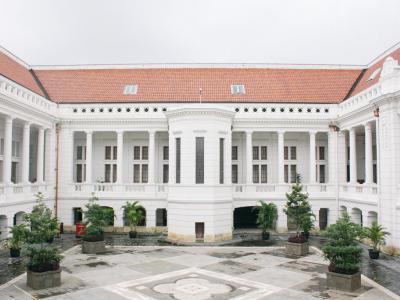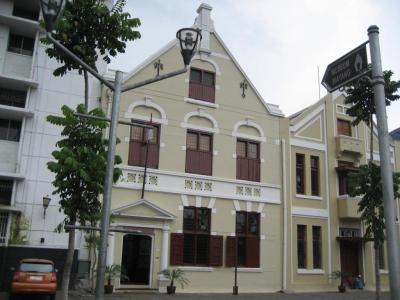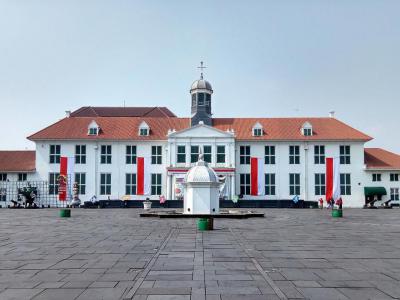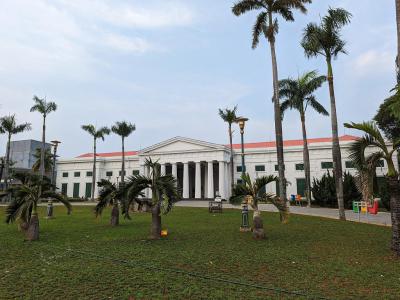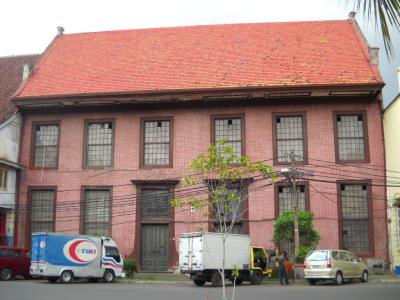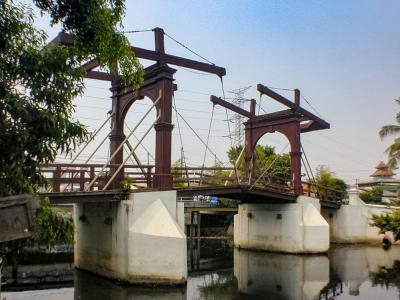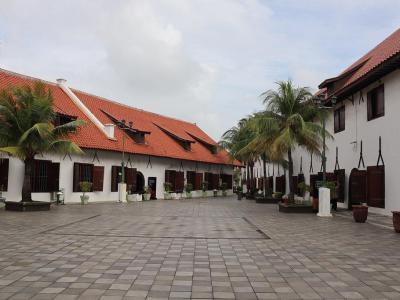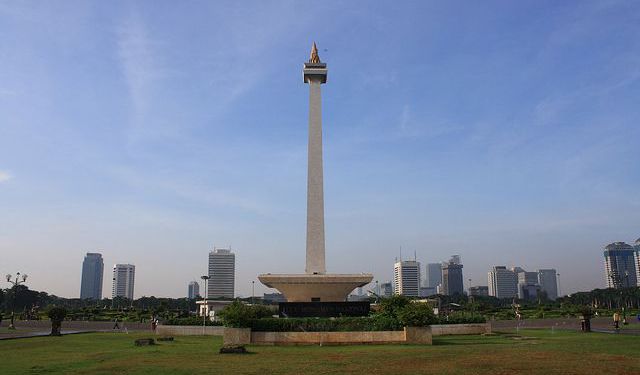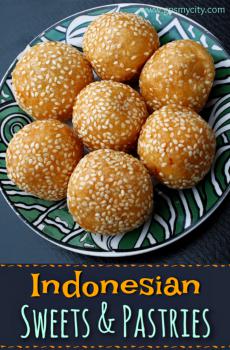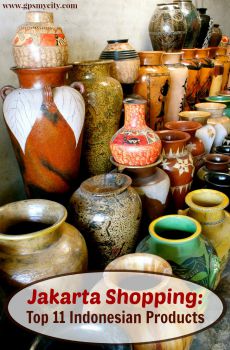Jakarta's Colonial Buildings (Self Guided), Jakarta
Throughout the centuries, the European powers, particularly the Dutch who colonized Indonesia from the 1800s until 1945, left their mark on Jakarta. At one time known as Batavia, the de-facto capital of the Dutch East Indies, today Jakarta boasts a wealth of old-time structures, featuring a fascinating blend of European and Javanese design influences.
One of the most prominent areas to explore colonial-era architecture here is the Old Town (Kota Tua), with many buildings dating back to the 17th and 18th centuries. Taman Fatahillah, a historic square in Kota Tua, is surrounded by colonial-style buildings, including the Jakarta History Museum or Museum Fatahillah, formerly the Batavia City Hall.
Among other notable examples are the Wayang Museum (housing a collection of Javanese shadow puppets), the Bank Indonesia Museum (located in the former Dutch East Indies Bank building), and the Jakarta Kota Railway Station (remodeled in 1929 to fit the Art Deco fad of the day), to mention but a few.
"Jakarta's architecture tells the story of its past." Indeed, apart from their purely architectural value, these centuries-old landmarks offer a window into the city's history, showcasing its cultural heritage.
If you wish to get a glimpse into the colonial past of Jakarta, this self-guided tour is a good vehicle for that.
One of the most prominent areas to explore colonial-era architecture here is the Old Town (Kota Tua), with many buildings dating back to the 17th and 18th centuries. Taman Fatahillah, a historic square in Kota Tua, is surrounded by colonial-style buildings, including the Jakarta History Museum or Museum Fatahillah, formerly the Batavia City Hall.
Among other notable examples are the Wayang Museum (housing a collection of Javanese shadow puppets), the Bank Indonesia Museum (located in the former Dutch East Indies Bank building), and the Jakarta Kota Railway Station (remodeled in 1929 to fit the Art Deco fad of the day), to mention but a few.
"Jakarta's architecture tells the story of its past." Indeed, apart from their purely architectural value, these centuries-old landmarks offer a window into the city's history, showcasing its cultural heritage.
If you wish to get a glimpse into the colonial past of Jakarta, this self-guided tour is a good vehicle for that.
How it works: Download the app "GPSmyCity: Walks in 1K+ Cities" from Apple App Store or Google Play Store to your mobile phone or tablet. The app turns your mobile device into a personal tour guide and its built-in GPS navigation functions guide you from one tour stop to next. The app works offline, so no data plan is needed when traveling abroad.
Jakarta's Colonial Buildings Map
Guide Name: Jakarta's Colonial Buildings
Guide Location: Indonesia » Jakarta (See other walking tours in Jakarta)
Guide Type: Self-guided Walking Tour (Sightseeing)
# of Attractions: 8
Tour Duration: 2 Hour(s)
Travel Distance: 2.7 Km or 1.7 Miles
Author: jenny
Sight(s) Featured in This Guide:
Guide Location: Indonesia » Jakarta (See other walking tours in Jakarta)
Guide Type: Self-guided Walking Tour (Sightseeing)
# of Attractions: 8
Tour Duration: 2 Hour(s)
Travel Distance: 2.7 Km or 1.7 Miles
Author: jenny
Sight(s) Featured in This Guide:
- Jakarta Kota Railway Station
- Bank Indonesia Museum
- Museum Wayang (Puppet Museum)
- Jakarta History Museum (Museum Fatahillah)
- Fine Art and Ceramic Museum (Seni Rupa dan Keramik)
- Toko Merah (Red Shop)
- Jembatan Pasar Ayam (Chicken Market Bridge)
- Museum Bahari (Maritime Museum)
1) Jakarta Kota Railway Station
Located in the historic Kota district of Jakarta, Jakarta Kota Station is a railway station that serves as the main hub for several intercity train lines across Java Island. Formerly known as South Batavia (Batavia Zuid), the station was renamed at the beginning of the 20th century. It is also known as Beos Station, which has several versions of its origin. One version suggests that the name comes from the Batavia Eastern Railway Company or BOS, the former owner of the Batavia station that was situated at the same location before it was demolished. Another version suggests that it comes from the phrase "Batavia and its Surroundings," reflecting the station's function as a transportation center that connects Batavia with other cities.
Designed by the Dutch architect Frans Johan Louwrens Ghijsels, Jakarta Kota Station is a two-story building with a mix of Western Art Deco and local architectural styles. Its main entrance and hall are characterized by a barrel vault roof with openings that are horizontally composed with the top dominated by vertical units (lunettes). The inside wall of the hall is finished with rough-textured brown ceramic, while the outside wall at the bottom of the building is covered with green-yellowish plaster. The station has six platforms serving 12 tracks, with canopies supported by steel columns.
In 2019, the station underwent renovations that included the addition of a new waiting area for long-distance trains. Furthermore, in February 2020, the English railroad switch and station scissors that had been in use for almost 50 years were replaced with newer ones.
Designed by the Dutch architect Frans Johan Louwrens Ghijsels, Jakarta Kota Station is a two-story building with a mix of Western Art Deco and local architectural styles. Its main entrance and hall are characterized by a barrel vault roof with openings that are horizontally composed with the top dominated by vertical units (lunettes). The inside wall of the hall is finished with rough-textured brown ceramic, while the outside wall at the bottom of the building is covered with green-yellowish plaster. The station has six platforms serving 12 tracks, with canopies supported by steel columns.
In 2019, the station underwent renovations that included the addition of a new waiting area for long-distance trains. Furthermore, in February 2020, the English railroad switch and station scissors that had been in use for almost 50 years were replaced with newer ones.
2) Bank Indonesia Museum
Bank Indonesia Museum in Jakarta's Old Town, established by Bank Indonesia, is housed in a historical building that boasts impressive architecture. It was originally the headquarters of the Netherlands Indies gulden, also known as De Javasche Bank, the central bank of the Dutch East Indies. When Indonesia gained independence in 1953, the bank became nationalized as Bank Indonesia.
The building that currently houses the museum was constructed in the early 18th century on the site of Batavia's Inner Hospital. It was abandoned in 1780 when the central hospital moved to Weltevreden. The original hospital building was demolished in the early 20th century, and a new building designed by Eduard Cuypers was constructed in its place. Cuypers was a renowned Dutch architect known for incorporating indigenous Indonesian elements into his designs. The building's front facade was completed in 1909 in Neo-Renaissance architecture with Javanese decorations integrated into its details. The inner court of the building underwent renovation in 1926, which resulted in the incorporation of Art Deco elements into the design.
The Bank Museum was inaugurated in 2009, after a series of renovations and improvements by local authorities. It presents Indonesia’s financial evolution, including its first contact with Europeans, the effects of Dutch colonization on financial life, and the machines used in the banking process. Visitors can view old typewriters, phones, telegraphs, ATMs, money counting machines, and computers, as well as admire gold bullions displayed in one of the museum’s rooms and enter the bank’s “secret” safe. Short movies highlight the changes suffered by the local currency along the way, while the banking jargon is explained on the walls of another room.
The building that currently houses the museum was constructed in the early 18th century on the site of Batavia's Inner Hospital. It was abandoned in 1780 when the central hospital moved to Weltevreden. The original hospital building was demolished in the early 20th century, and a new building designed by Eduard Cuypers was constructed in its place. Cuypers was a renowned Dutch architect known for incorporating indigenous Indonesian elements into his designs. The building's front facade was completed in 1909 in Neo-Renaissance architecture with Javanese decorations integrated into its details. The inner court of the building underwent renovation in 1926, which resulted in the incorporation of Art Deco elements into the design.
The Bank Museum was inaugurated in 2009, after a series of renovations and improvements by local authorities. It presents Indonesia’s financial evolution, including its first contact with Europeans, the effects of Dutch colonization on financial life, and the machines used in the banking process. Visitors can view old typewriters, phones, telegraphs, ATMs, money counting machines, and computers, as well as admire gold bullions displayed in one of the museum’s rooms and enter the bank’s “secret” safe. Short movies highlight the changes suffered by the local currency along the way, while the banking jargon is explained on the walls of another room.
3) Museum Wayang (Puppet Museum)
The Museum Wayang, established in 1975, is dedicated to preserving the centuries-old tradition of wayang, an art form that involves the use of specially crafted puppets. Also known as shadow theatre, these theatrical pieces serve both an entertaining and moralizing purpose by promoting traditional customs and values.
The museum, which houses over 5,000 exhibits, mostly wayang puppets made in Indonesia, is located on the site of the former Old Dutch Church that was first built in 1640. The church was later renovated in 1732 and renamed the New Dutch Church, but it was destroyed by an earthquake in 1808. A new building was constructed on the same site in the Neo-Renaissance style in 1912, which was initially used as a warehouse and later renovated in 1938 to reflect Dutch colonial architecture. The garden of the Wayang Museum, located in the former churchyard, was the burial site of former colonial General Governor Jan Pieterszoon Coen.
In 1939, the Batavia Society of Arts and Sciences bought the building and turned it into a museum called the Old Batavia Museum. After Indonesia gained independence in 1945, the building was transferred to the Institute of Indonesian Culture and then to the Ministry of Education and Culture in 1962.
Finally, in 1968, the DKI Jakarta Administration established the Wayang Museum, which opened on August 13, 1975. Along with wayang puppets from Java, Bali, Sumatra, Sunda, and Lombok, the museum also showcases international items from China, India, Pakistan, Vietnam, Malaysia, Suriname, France, Kelantan, England, and the United States. In addition to the puppet displays, the museum exhibits tools and equipment used in puppet crafting, and occasional demonstrations are conducted to introduce tourists to the art of puppetry.
The museum, which houses over 5,000 exhibits, mostly wayang puppets made in Indonesia, is located on the site of the former Old Dutch Church that was first built in 1640. The church was later renovated in 1732 and renamed the New Dutch Church, but it was destroyed by an earthquake in 1808. A new building was constructed on the same site in the Neo-Renaissance style in 1912, which was initially used as a warehouse and later renovated in 1938 to reflect Dutch colonial architecture. The garden of the Wayang Museum, located in the former churchyard, was the burial site of former colonial General Governor Jan Pieterszoon Coen.
In 1939, the Batavia Society of Arts and Sciences bought the building and turned it into a museum called the Old Batavia Museum. After Indonesia gained independence in 1945, the building was transferred to the Institute of Indonesian Culture and then to the Ministry of Education and Culture in 1962.
Finally, in 1968, the DKI Jakarta Administration established the Wayang Museum, which opened on August 13, 1975. Along with wayang puppets from Java, Bali, Sumatra, Sunda, and Lombok, the museum also showcases international items from China, India, Pakistan, Vietnam, Malaysia, Suriname, France, Kelantan, England, and the United States. In addition to the puppet displays, the museum exhibits tools and equipment used in puppet crafting, and occasional demonstrations are conducted to introduce tourists to the art of puppetry.
4) Jakarta History Museum (Museum Fatahillah)
The Jakarta History Museum, known as the Fatahillah Museum or Batavia Museum, is nestled within Jakarta's Old Town. Established in 1974, the museum features a diverse array of artifacts from Jakarta's prehistoric times, the establishment of Jayakarta in 1527, and the Dutch colonial era spanning from the 16th century to Indonesia's independence in 1945.
Previously serving as Batavia's city hall, the museum building was erected in 1627 at the same location as the current structure. A significant renovation took place in 1707, resulting in several features of the present-day building, including the portico. The portico, with its series of columns and triangular pediment, adds an element of grandeur and sophistication to the exterior.
The building is characterized by its large timber beams and floorboards, encompassing 37 elaborately ornated rooms. The building's design was inspired by the Royal Palace in Amsterdam, showcasing a domed cupola and proportions characteristic of a 17th-century Dutch city hall.
As one of Indonesia's most extensive museums, the History Museum boasts an impressive 23,500 exhibits. Among these, the oldest is a replica of the 5th-century Tugu Inscription. The museum also features maps, drawings, and a monument commemorating the friendship between the Sunda and Portuguese peoples, which provide insights into the city's founding in the 16th century.
The museum's rich furniture collection spans the 16th through 18th centuries, illustrating the evolution of Indonesian society. A unique and captivating style emerges from the fusion of European, Chinese, and indigenous influences, defining the local culture and civilization. This furniture collection is considered the world's most comprehensive colonial assortment.
An array of art pieces, glassware, pottery, stone and wood carvings, swords, metal objects, and leather and cloth items are displayed in specialized collections. These pieces are organized chronologically, presenting Indonesian history through their antiquated appearance.
When visiting the museum, be sure to explore the basement cells and Fatahillah Square-named after Jakarta's founder, Prince Fatahillah-for a thorough understanding of the locale.
Previously serving as Batavia's city hall, the museum building was erected in 1627 at the same location as the current structure. A significant renovation took place in 1707, resulting in several features of the present-day building, including the portico. The portico, with its series of columns and triangular pediment, adds an element of grandeur and sophistication to the exterior.
The building is characterized by its large timber beams and floorboards, encompassing 37 elaborately ornated rooms. The building's design was inspired by the Royal Palace in Amsterdam, showcasing a domed cupola and proportions characteristic of a 17th-century Dutch city hall.
As one of Indonesia's most extensive museums, the History Museum boasts an impressive 23,500 exhibits. Among these, the oldest is a replica of the 5th-century Tugu Inscription. The museum also features maps, drawings, and a monument commemorating the friendship between the Sunda and Portuguese peoples, which provide insights into the city's founding in the 16th century.
The museum's rich furniture collection spans the 16th through 18th centuries, illustrating the evolution of Indonesian society. A unique and captivating style emerges from the fusion of European, Chinese, and indigenous influences, defining the local culture and civilization. This furniture collection is considered the world's most comprehensive colonial assortment.
An array of art pieces, glassware, pottery, stone and wood carvings, swords, metal objects, and leather and cloth items are displayed in specialized collections. These pieces are organized chronologically, presenting Indonesian history through their antiquated appearance.
When visiting the museum, be sure to explore the basement cells and Fatahillah Square-named after Jakarta's founder, Prince Fatahillah-for a thorough understanding of the locale.
5) Fine Art and Ceramic Museum (Seni Rupa dan Keramik)
The Fine Arts Museum is a must-visit for tourists, located in the Old City (Kota Tua) and surrounded by popular tourist attractions like the Maritime Museum, Jembatan Pasar Ayam (Chicken Market Bridge), Red Shop, and Sunda Kelapa Harbor.
The grand white Neoclassical building with a columned portico situated on the eastern side of Fatahillah Square was originally built as the Dutch Supreme Judiciary in 1870. Visitors can admire the impressive columns projecting from the marble floors, stroll through the lovely interior courtyard gardens, and climb the iron spiral staircase to the second floor. Over the years, the building has served various purposes, from the West Jakarta Mayor's Office to a military barracks, and since 1976, it has functioned as a museum.
The museum is divided into two sections: the fine art section and the ceramic section. The fine art section boasts over 400 paintings by renowned local artists like Raden Saleh, Dullah, S. Sudjojono, and Affandi, as well as sculptures from Bali, wooden totems, and magical objects displayed in the Balai Seni Rupa.
Meanwhile, the ceramic section showcases objects from Indonesia and neighboring countries, including China, with whom Indonesia has had significant economic relations. The collection features ceramic pieces from Japan, Vietnam, Thailand, Germany, Holland, and the Middle East, with some items dating back to the 16th century.
Visitors can purchase souvenirs and participate in a ceramic workshop, where they can create their own ceramic objects. Don't miss out on this wonderful museum experience!
The grand white Neoclassical building with a columned portico situated on the eastern side of Fatahillah Square was originally built as the Dutch Supreme Judiciary in 1870. Visitors can admire the impressive columns projecting from the marble floors, stroll through the lovely interior courtyard gardens, and climb the iron spiral staircase to the second floor. Over the years, the building has served various purposes, from the West Jakarta Mayor's Office to a military barracks, and since 1976, it has functioned as a museum.
The museum is divided into two sections: the fine art section and the ceramic section. The fine art section boasts over 400 paintings by renowned local artists like Raden Saleh, Dullah, S. Sudjojono, and Affandi, as well as sculptures from Bali, wooden totems, and magical objects displayed in the Balai Seni Rupa.
Meanwhile, the ceramic section showcases objects from Indonesia and neighboring countries, including China, with whom Indonesia has had significant economic relations. The collection features ceramic pieces from Japan, Vietnam, Thailand, Germany, Holland, and the Middle East, with some items dating back to the 16th century.
Visitors can purchase souvenirs and participate in a ceramic workshop, where they can create their own ceramic objects. Don't miss out on this wonderful museum experience!
6) Toko Merah (Red Shop)
Toko Merah, meaning "Red Shop" in Indonesian, is a historic Dutch colonial landmark situated in Jakarta's Old Town. Constructed in 1730, it is one of the oldest structures in Jakarta and stands on a 2,471 square meter plot on the west side of the primary canal, Kali Besar. The building's red hue is the reason behind its current name.
The building was initially constructed as the residence of Gustaaf Willem, Baron van Imhoff, the Governor-General of the Dutch East Indies from 1743 to 1750. It served as the oldest navy academy in Asia, the Dutch Academie de Marine, from 1743 to 1755. Over time, the ownership of the building changed hands several times. It served as the dwelling of various Governors-General of the Dutch East Indies.
Between 1786 and 1808, the building was converted into a hotel. During this period, additional structures such as rows of carriage houses and stables were built to accommodate the hotel's eight carriages and sixteen horses. These ancillary buildings were subsequently transformed into row houses. The building also provided six boats on the Kali Besar Channel for transporting goods from Sunda Kelapa harbor.
In 1851, Oey Liauw Kong, Chinese-Indonesian high official, acquired the building for use as his residence and store. He painted it red, and it was henceforth known as Toko Merah (Red Shop). The building underwent restoration by J.F. van Hoytema in 1920 and subsequently served as the office for the Bank of India (Bank voor Indië) from 1920 to 1940. Following that, it was utilized as the office of an international Dutch-owned company.
The architectural style of the building conforms to the earliest period of Dutch colonial architecture, which is the tropical equivalent of 17th-century Dutch architecture. The building features high sash windows with split shutters and gable roofs typical of Dutch architecture. The structure is solidly built with relatively enclosed structures, which is not particularly well-suited to the tropical climate as compared to the Dutch colonial architecture of the subsequent period in Jakarta.
The building was initially constructed as the residence of Gustaaf Willem, Baron van Imhoff, the Governor-General of the Dutch East Indies from 1743 to 1750. It served as the oldest navy academy in Asia, the Dutch Academie de Marine, from 1743 to 1755. Over time, the ownership of the building changed hands several times. It served as the dwelling of various Governors-General of the Dutch East Indies.
Between 1786 and 1808, the building was converted into a hotel. During this period, additional structures such as rows of carriage houses and stables were built to accommodate the hotel's eight carriages and sixteen horses. These ancillary buildings were subsequently transformed into row houses. The building also provided six boats on the Kali Besar Channel for transporting goods from Sunda Kelapa harbor.
In 1851, Oey Liauw Kong, Chinese-Indonesian high official, acquired the building for use as his residence and store. He painted it red, and it was henceforth known as Toko Merah (Red Shop). The building underwent restoration by J.F. van Hoytema in 1920 and subsequently served as the office for the Bank of India (Bank voor Indië) from 1920 to 1940. Following that, it was utilized as the office of an international Dutch-owned company.
The architectural style of the building conforms to the earliest period of Dutch colonial architecture, which is the tropical equivalent of 17th-century Dutch architecture. The building features high sash windows with split shutters and gable roofs typical of Dutch architecture. The structure is solidly built with relatively enclosed structures, which is not particularly well-suited to the tropical climate as compared to the Dutch colonial architecture of the subsequent period in Jakarta.
7) Jembatan Pasar Ayam (Chicken Market Bridge)
Jembatan Pasar Ayam or Chicken Market Bridge (also known as Kota Intan Bridge) is a historical wooden bridge located in the Kota Tua area of Jakarta. Built in 1628 by the Dutch East India Company during the Dutch colonial period, it is the oldest surviving bridge in Indonesia. Originally named English Bridge, it connected Dutch and British fortifications across the Grand Canal, reflecting the area's strategic military significance.
The bridge was strategically positioned near a bustling chicken market, which later influenced its name change to "Chicken Market Bridge". Its design as a Bascule bridge, featuring a double "leaf" that could swing upward, facilitated the passage of ships along the canal. This mechanical feature was crucial for accommodating the heavy maritime traffic of the era.
Over the centuries, the bridge has undergone several renovations and name changes, reflecting shifts in political power and administrative priorities. After suffering damage from military conflicts and natural disasters, it was rebuilt and renamed multiple times, including being called The Central Bridge, and later the Queen Juliana Bridge during the reign of Queen Juliana.
Today, while no longer operational for its original purpose, the Chicken Market Bridge serves as a pedestrian bridge and a cultural landmark. It attracts tourists interested in the rich history of Jakarta and is managed by the Jakarta Provincial Tourism and Culture Department. Despite its non-functional state, the bridge retains its historic architectural style and remains a testament to the area's vibrant past. Legends even suggest that Vincent Van Gogh, during his visit to Batavia, admired the bridge, adding a layer of artistic heritage to its historical narrative.
The bridge was strategically positioned near a bustling chicken market, which later influenced its name change to "Chicken Market Bridge". Its design as a Bascule bridge, featuring a double "leaf" that could swing upward, facilitated the passage of ships along the canal. This mechanical feature was crucial for accommodating the heavy maritime traffic of the era.
Over the centuries, the bridge has undergone several renovations and name changes, reflecting shifts in political power and administrative priorities. After suffering damage from military conflicts and natural disasters, it was rebuilt and renamed multiple times, including being called The Central Bridge, and later the Queen Juliana Bridge during the reign of Queen Juliana.
Today, while no longer operational for its original purpose, the Chicken Market Bridge serves as a pedestrian bridge and a cultural landmark. It attracts tourists interested in the rich history of Jakarta and is managed by the Jakarta Provincial Tourism and Culture Department. Despite its non-functional state, the bridge retains its historic architectural style and remains a testament to the area's vibrant past. Legends even suggest that Vincent Van Gogh, during his visit to Batavia, admired the bridge, adding a layer of artistic heritage to its historical narrative.
8) Museum Bahari (Maritime Museum)
Hosted by the former Dutch East India Company warehouses, the Museum Bahari (Maritime Museum in Indonesian) offers tourists an excursion in the maritime history of the Indonesian archipelago.
The buildings accommodating the maritime collections have a long and interesting history themselves. There are two groups of warehouses, one on the west bank of the Ciliwung River (or the Westzijdsche Pakhuizen) and one group on the east bank (or the Oostzijdsche Pakhuizen). Three out of the four warehouses located on the west bank are now used for the Museum Bahari.
The oldest warehouses were built during the 16th century in the Dutch architectural style and were used by the Vereenigde Oostindische Compagnie (VOC) as storage space for spices, clothes, tea and coffee. More storage spaces were built in the 17th century, while some of the oldest ones were modified and improved so as to offer more space for the increasing volume of merchandise transiting the Jakarta harbor.
Museum Bahari features an impressive collection of boat replicas gathered from all over the Indonesian archipelago. A rare collection of pinisi and kora-kora (war vessels) replicas as well as original boats can be admired inside the museum. Other collections include the Indonesian naval history depicted in unique pictures taken on sea and in local harbors, a collection dedicated to the local maritime flora and fauna and a special collection gathering all the tools and specific Indonesian items used in maritime transport.
The buildings accommodating the maritime collections have a long and interesting history themselves. There are two groups of warehouses, one on the west bank of the Ciliwung River (or the Westzijdsche Pakhuizen) and one group on the east bank (or the Oostzijdsche Pakhuizen). Three out of the four warehouses located on the west bank are now used for the Museum Bahari.
The oldest warehouses were built during the 16th century in the Dutch architectural style and were used by the Vereenigde Oostindische Compagnie (VOC) as storage space for spices, clothes, tea and coffee. More storage spaces were built in the 17th century, while some of the oldest ones were modified and improved so as to offer more space for the increasing volume of merchandise transiting the Jakarta harbor.
Museum Bahari features an impressive collection of boat replicas gathered from all over the Indonesian archipelago. A rare collection of pinisi and kora-kora (war vessels) replicas as well as original boats can be admired inside the museum. Other collections include the Indonesian naval history depicted in unique pictures taken on sea and in local harbors, a collection dedicated to the local maritime flora and fauna and a special collection gathering all the tools and specific Indonesian items used in maritime transport.
Walking Tours in Jakarta, Indonesia
Create Your Own Walk in Jakarta
Creating your own self-guided walk in Jakarta is easy and fun. Choose the city attractions that you want to see and a walk route map will be created just for you. You can even set your hotel as the start point of the walk.
Jakarta Introduction Walking Tour
The capital of Indonesia, Jakarta, is a massive, fast-paced metropolis and a melting pot of cultures – Asian and European – that historically coexisted and imprinted their influence on the city's architecture, language, cuisine, and lifestyle. The local Istiqlal Mosque is the largest Islamic temple in Southeast Asia, while the Neo-Gothic Gereja Katedral, also known as the Jakarta... view more
Tour Duration: 2 Hour(s)
Travel Distance: 4.1 Km or 2.5 Miles
Tour Duration: 2 Hour(s)
Travel Distance: 4.1 Km or 2.5 Miles
Useful Travel Guides for Planning Your Trip
Indonesian Sweets and Pastries
Spread across an archipelago of islands accommodating hundreds of ethnicities speaking many different languages, Indonesia is a cluster of just as many culinary traditions. And just as any other Asian culinary, Indonesian cuisine can't be imagined without a dollop of sweetness. Some of the...
Jakarta Shopping Guide: Top 11 Indonesian Products
The world's largest Muslim-populated country, Indonesia is also a mecca for tourists, drawing millions each year to her thousands of volcanic islands scattered between the Pacific and Indian oceans. The country's ethnic diversity has given rise to the lavish and colorful arts and...
The Most Popular Cities
/ view all




